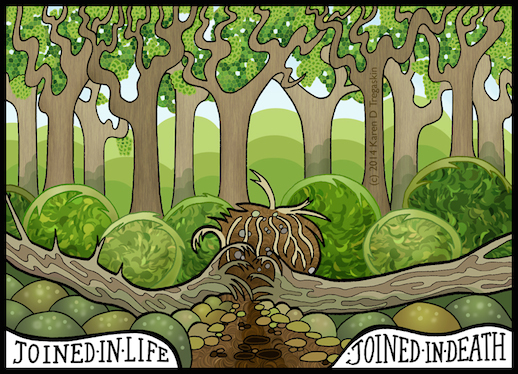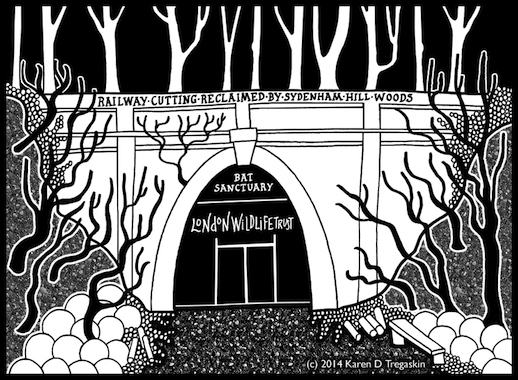Words and pictures by Karen D Tregaskin
11: Dulwich Woods
I walked up through Kingswood, another grand Victorian mansion, formerly belonging to the inventor of Bovril, now enjoying an afterlife as library and community centre for the council estate which has also inherited its incongruously grand entrance gates and tree-lined drive. Then up another bone-joltingly steep footpath, passing the distinctive oaks and hornbeams of genuine old growth forest, into Dulwich Woods, the largest and most undisturbed of the Great North Wood fragments, preserved in private ownership by the Dulwich Estate. A few paces in, and I realise that I can almost tell which of the woods I’ve visited are ancient, just by the smell of them. I’m not sure if it’s pollen from the profuse flowers of the undergrowth or fungus spores (the wood hosts over 200 species of fungi) or just centuries of accumulated leaf mould, but there is a distinctive scent to older woods, like the must of second hand bookshops. That smell is present in Dulwich (and bits of Biggin and Convent Woods) but is missing even half a mile way in the Victorian era railway cuttings bisecting its conjoined twin of Sydenham Hill Woods. My passage along the muddy trails, soaked and deeply rutted by springtime rains, was blocked by a fallen tree I had to carefully pick my way around. The downed oak had also been twins, each trunk fallen in opposite directions, crushing opportunistic ash and sycamore seedlings at its base, its massive rootball pointing towards the unexpected patch of pale sky opened in the dense green canopy.
12: Sydenham Hill Tunnel
Sydenham Hill is the newer of the twin woods, a mixture of relict trees and more modern woodlands reclaimed from railway cuttings and Victorian back gardens, but again with a diversity of wildlife greatly helped by its proximity to the ancient woodlands of Dulwich. This patch of woods was the site of bitter campaigning against development during the early 90s, spearheaded by the now-defunct Friends of the Great North Wood. This tunnel (the other end of which is also a tiny woodland, by Sydenham Wells Park) is a Beeching-era closure, now completely reverted to nature. The London Wildlife Trust currently runs it as a bat sanctuary, and there is a pleasant nature trail down the length of it. I pass over the wooden footbridge (from which Pissaro painted a scalped landscape duplicated on a plaque) to find the ruins before heading for the Horniman, but if you carry on in the opposite direction, Cox’s Walk, an avenue of pollarded oaks cut in 1739, still leads from the Sydenham Wells to the pleasure gardens (and pubs) of Dulwich.
Ghosts of the Great North Wood archive.
For more illustrations, please visit Karen D Tregaskin’s Flickr / Tumblr/ Twitter

